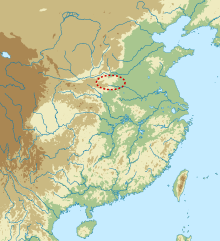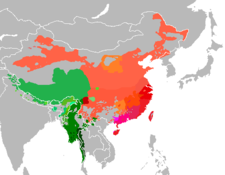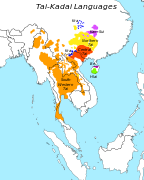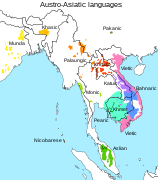
The Austroasiatic languages are a large language family spoken throughout mainland Southeast Asia, South Asia and East Asia. These languages are natively spoken by the majority of the population in Vietnam and Cambodia, and by minority populations scattered throughout parts of Thailand, Laos, India, Myanmar, Malaysia, Bangladesh, Nepal, and southern China. Approximately 117 million people speak an Austroasiatic language, of which more than two-thirds are Vietnamese speakers. Of the Austroasiatic languages, only Vietnamese, Khmer, and Mon have lengthy, established presences in the historical record. Only two are presently considered to be the national languages of sovereign states: Vietnamese in Vietnam, and Khmer in Cambodia. The Mon language is a recognized indigenous language in Myanmar and Thailand, while the Wa language is a 'recognized national language' in the de facto autonomous Wa State within Myanmar. Santali is one of the 22 scheduled languages of India. The remainder of the family's languages are spoken by minority groups and have no official status.

Sino-Tibetan, also cited as Trans-Himalayan in a few sources, is a family of more than 400 languages, second only to Indo-European in number of native speakers. Around 1.4 billion people speak a Sino-Tibetan language. The vast majority of these are the 1.3 billion native speakers of Sinitic languages. Other Sino-Tibetan languages with large numbers of speakers include Burmese and the Tibetic languages. Other languages of the family are spoken in the Himalayas, the Southeast Asian Massif, and the eastern edge of the Tibetan Plateau. Most of these have small speech communities in remote mountain areas, and as such are poorly documented.
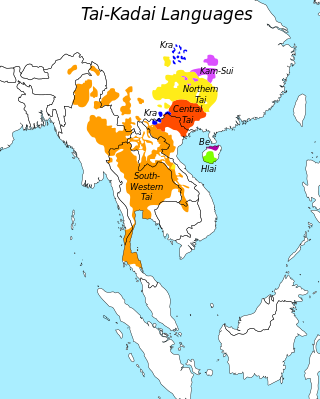
The Kra–Dai languages, are a language family in Mainland Southeast Asia, Southern China and Northeastern India. All languages in the family are tonal, including Thai and Lao, the national languages of Thailand and Laos, respectively. Around 93 million people speak Kra–Dai languages; 60% of those speak Thai. Ethnologue lists 95 languages in the family, with 62 of these being in the Tai branch.

The Austronesian languages are a language family widely spoken throughout Maritime Southeast Asia, parts of Mainland Southeast Asia, Madagascar, the islands of the Pacific Ocean and Taiwan. They are spoken by about 386 million people. This makes it the fifth-largest language family by number of speakers. Major Austronesian languages include Malay, Javanese, Sundanese, Tagalog (Filipino), Malagasy and Cebuano. According to some estimates, the family contains 1,257 languages, which is the second most of any language family.
The languages of East Asia belong to several distinct language families, with many common features attributed to interaction. In the Mainland Southeast Asia linguistic area, Chinese varieties and languages of southeast Asia share many areal features, tending to be analytic languages with similar syllable and tone structure. In the 1st millennium AD, Chinese culture came to dominate East Asia, and Classical Chinese was adopted by scholars and ruling classes in Vietnam, Korea, and Japan. As a consequence, there was a massive influx of loanwords from Chinese vocabulary into these and other neighboring Asian languages. The Chinese script was also adapted to write Vietnamese, Korean and Japanese, though in the first two the use of Chinese characters is now restricted to university learning, linguistic or historical study, artistic or decorative works and newspapers, rather than daily usage.

The Hmong–Mien languages are a highly tonal language family of southern China and northern Southeast Asia. They are spoken in mountainous areas of southern China, including Guizhou, Hunan, Yunnan, Sichuan, Guangxi, and Hubei provinces; the speakers of these languages are predominantly "hill people", in contrast to the neighboring Han Chinese, who have settled the more fertile river valleys.

The Austric languages are a proposed language family that includes the Austronesian languages spoken in Taiwan, Maritime Southeast Asia, the Pacific Islands, and Madagascar, as well as Kra–Dai and Austroasiatic languages spoken in Mainland Southeast Asia and South Asia. A genetic relationship between these language families is seen as plausible by some scholars, but remains unproven.

Borean is a hypothetical linguistic macrofamily that encompasses almost all language families worldwide except those native to the Americas, Africa, Oceania, and the Andaman Islands. Its supporters propose that the various languages spoken in Eurasia and adjacent regions have a genealogical relationship, and ultimately descend from languages spoken during the Upper Paleolithic in the millennia following the Last Glacial Maximum. The name Borean is based on the Greek βορέας, and means "northern". This reflects the fact that the group is held to include most language families native to the northern hemisphere. Two distinct models of Borean exist: that of Harold C. Fleming and that of Sergei Starostin.
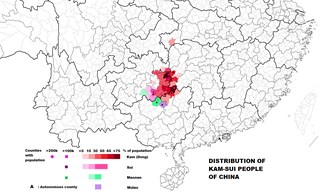
The Kam–Sui peoples are a group of related ethnic groups in China and neighboring portions of Northern Laos and Vietnam. They are defined as speakers of Kam–Sui languages, which belong linguistically to the Kra–Dai languages.
The Austro-Tai languages, sometimes also Austro-Thai languages, are a proposed language family that comprises the Austronesian languages and the Kra–Dai languages.
The Kra languages are a branch of the Kra–Dai language family spoken in southern China and in northern Vietnam.
Sino-Austronesian or Sino-Tibetan-Austronesian is a proposed language family suggested by Laurent Sagart in 1990. Using reconstructions of Old Chinese, Sagart argued that the Austronesian languages are related to the Sinitic languages phonologically, lexically and morphologically. Sagart later accepted the Sino-Tibetan languages as a valid group and extended his proposal to include the rest of Sino-Tibetan. He also placed the Tai–Kadai languages within the Austronesian family as a sister branch of Malayo-Polynesian. The proposal has been largely rejected by other linguists who argue that the similarities between Austronesian and Sino-Tibetan more likely arose from contact rather than being genetic.
Proto-Tai is the reconstructed proto-language of all the Tai languages, including modern Lao, Shan, Tai Lü, Tai Dam, Ahom, Northern Thai, Standard Thai, Bouyei, and Zhuang. The Proto-Tai language is not directly attested by any surviving texts, but has been reconstructed using the comparative method.
There have been various classification schemes for Southeast Asian languages.
Proto-Hmong–Mien (PHM), also known as Proto-Miao–Yao, is the reconstructed ancestor of the Hmong–Mien languages. Lower-level reconstructions include Proto-Hmongic and Proto-Mienic.
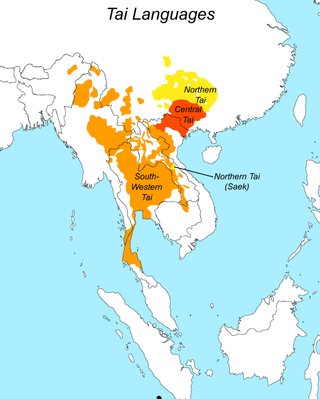
Tai peoples are the populations who speak the Tai languages. There are a total of about 93 million people of Tai ancestry worldwide, with the largest ethnic groups being Dai, Thais, Isan, Tai Yai (Shan), Lao, Tai Ahom, and Northern Thai peoples.

The Mainland Southeast Asia linguistic area is a sprachbund including languages of the Sino-Tibetan, Hmong–Mien, Kra–Dai, Austronesian and Austroasiatic families spoken in an area stretching from Thailand to China. Neighbouring languages across these families, though presumed unrelated, often have similar typological features, which are believed to have spread by diffusion. James Matisoff referred to this area as the "Sinosphere", contrasted with the "Indosphere", but viewed it as a zone of mutual influence in the ancient period.
Proto-Kra–Dai is the proposed reconstructed ancestor of the Kra–Dai languages.

Ilia Peiros is a Russian linguist who specializes in the historical linguistics of East Asia. Peiros is a well-known scholar in the Moscow School of Comparative Linguistics, known for its work on long-range comparative linguistics. Peiros is affiliated with the Santa Fe Institute in New Mexico, United States and was also a former faculty member at the University of Melbourne.
